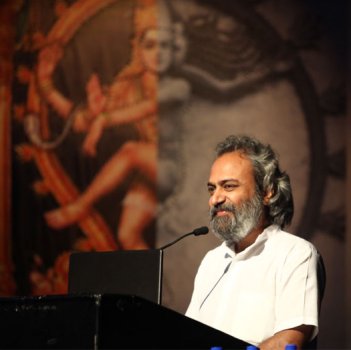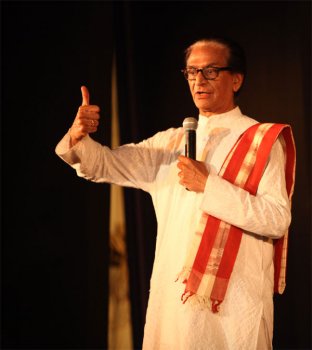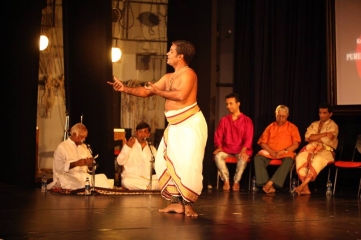
|   |

|   |
Dec 21: The male body in film and on stage - Kiran Rajagopalan e-mail: kiran.rajagopalan@gmail.com Pics: Vivekanandan December 21, 2013 The second morning of the ‘Purush’ conclave opened with convener Dr. Anita Ratnam’s astute summary of the events over the past three days. She then urged the few young dancers in the audience to properly ground themselves in dance technique before starting their own creative work. She also reiterated the notion of how easy it is to become “imitative” rather than introspective in a “world with too many easily accessible images.”
It was a provocative segue into ‘Guru Dakshina,’ a moving tribute to eleven men who have made unique and invaluable contributions to the field of Indian dance. The honorees were: Udupi Laxminarayan, K. Kalyanasundaram, Adyar K. Lakshman, B. Herambanathan, C.V. Chandrasekhar, V.P. Dhananjayan, C.K. Balagopalan, A. Janardhanan, M.V. Narasimhachari, Ramli Ibrahim, and Sunil Kothari. A brief film with rare pictures and videos of these distinguished men was highlighted tastefully with subtle drumming by Krishna Kishore. Senior dancer Lakshmi Viswanathan concluded the celebration with a refreshingly witty “fireside chat” about her “distinct memories of [her] experiences with each of the gurus.” Ashish Khokar then presented a short documentary ‘Purusha: Male Moves,’ which explored male dancing over the last century in India using precious footage from the Khokar Dance Archives. Rasikas were given glimpses into the artistry of several pioneering male artistes of various styles of dance. Some of the artistes featured in the documentary include: Ram Gopal, Uday Shankar, Birju Maharaj, Kelucharan Mohapatra, and Astad Deboo. Khokar also noted an interesting development in classical dance performance. Over the years, there has been a gradual shift in emphasis from aharya to stagecraft due to significant advances in technology.  Ashish Mohan Khokar  CV Chandrasekhar  Hari Krishnan, Dr, B M Sundaram, Shanmugha Sundaram, Guru Herambanathan, Hariharan  Guru Herambanathan & Hariharan The last session was a lecture-demonstration on “Bharatanatyam and the male body” with Dr. B.M. Sundaram, B. Herambanathan, and Prof. C.V. Chandrasekhar discussing and showcasing the Vazhuvoor, Thanjavur, and Kalakshetra styles, respectively. Dr. Sundaram began with a brief history of the major exponents of the Vazhuvoor school, and K. Shanmuga Sundaram performed two classic items from its repertoire. He began with the ‘Manduka Sabdam’ (Ragamalika; misra chapu; Melattur Kasinathayya), a popular composition among Kuchipudi artistes but seldom performed in Bharatanatyam. He ended with Gopalakrishna Bharathi’s famous kriti, “Natanam Adinar” (Vasantha; khanda ata). Both Guru Herambanathan and co-curator Hari Krishnan highlighted the difficulty of assigning a set aesthetic to the Thanjavur style. This stems from the fact that this region once boasted of many traditional nattuvanar families, and each had developed their own distinct style. The artistic legacy that Herambanathan has inherited from his ancestors was demonstrated by his son H. Hariharan, in an excerpt from the classic Thanjai Ponnaiya composition, “Sakhiye” (Anandabhairavi; adi). Finally, Prof. Chandrasekhar clarified that the Kalakshetra style is an extension of the Thanjavur school, and it has evolved from Rukmini Devi Arundale’s own aesthetic inclinations. She was keen to instill in her students a deep appreciation and understanding of the body, and she emphasized precise technique to highlight the chiseled geometry of Bharatanatyam. In fact, Prof. Chandrasekhar continues to adhere to his mentor’s preference for crisp jatis so that the beauty of the style can be maintained during performance. This was clearly seen in P. Praveen Kumar’s rendition of “Sankara Rudra Dupa” (Shankara; adi), aptly choreographed and tuned by Chandrasekhar. Interestingly, all of the participants wholeheartedly agreed with co-curator Hari Krishnan’s deliberate use of the word style – instead of the bani – to denote their respective schools. Unfortunately, Krishnan was unable to engage in further discussion with the panelists on how dance technique was instilled in and modified on the male body due to time constraints. This would have greatly enhanced the session, and it would have been extremely valuable for male students. Perhaps some time could have been saved had the demonstrations been shorter in length. Kiran Rajagopalan, disciple of A. Lakshmanaswamy, is a Bharatanatyam dancer based in Chennai. |